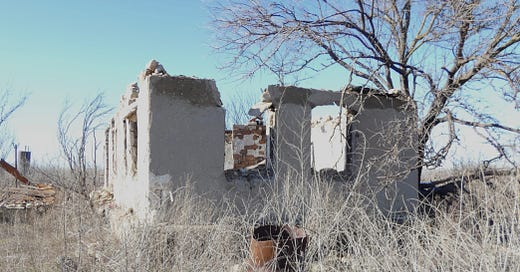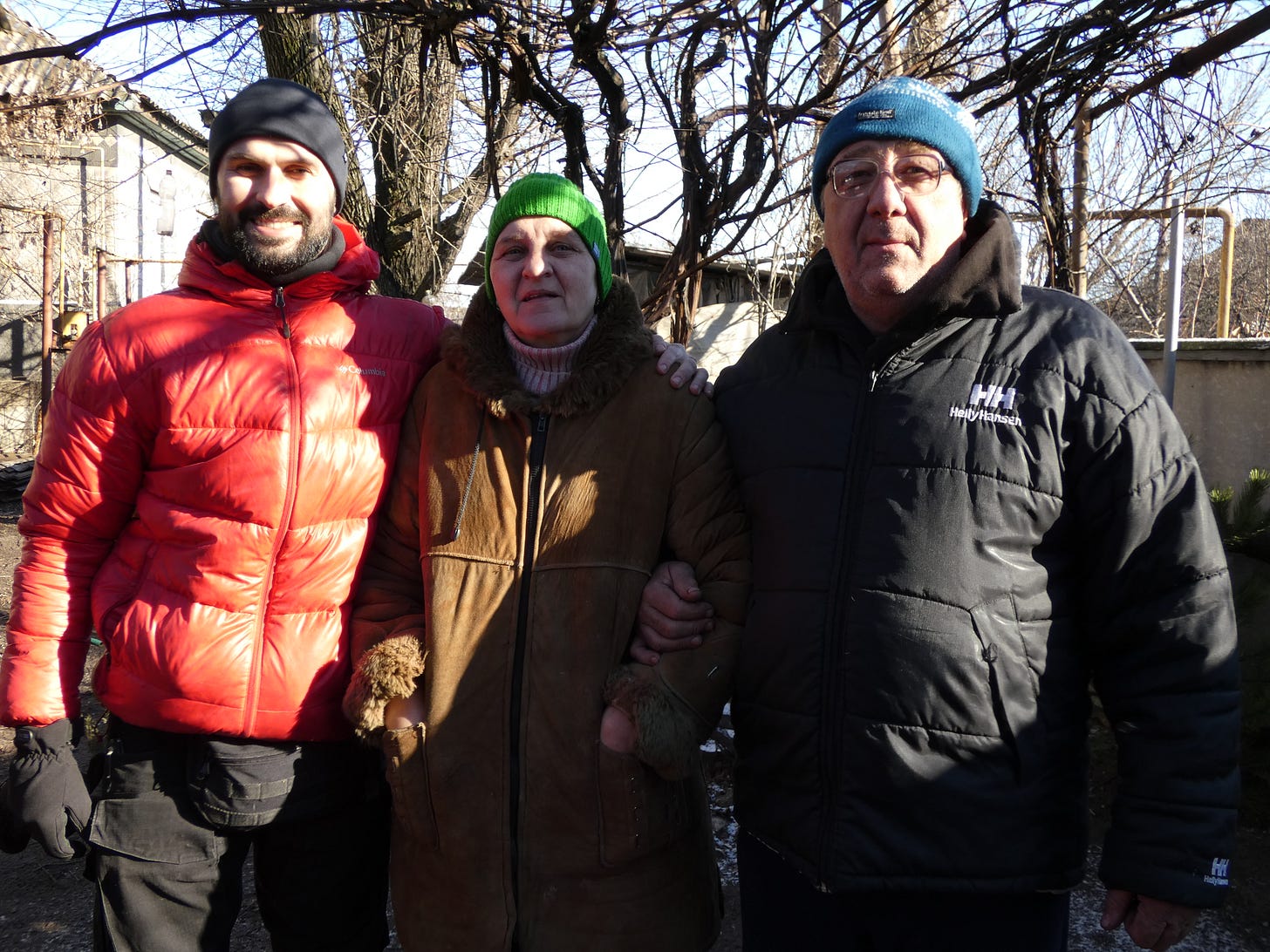A home destroyed by Russian shelling in the village of Syze in the Donbas region of southeastern Ukraine is shown on Feb. 15, 2022. The area came under occupation nine days later as Russia’s full-scale invasion began. (c. Martin Kuz)
The charred rubble stretched across hundreds of miles in the villages and towns of southeastern Ukraine. Homes, schools, churches, cafes, hospitals, factories — so much lay in ruin that once had stood upright. In a settlement a few miles from Russia, Dmytro Dyblia lifted a hand off his van’s steering wheel to gesture toward a gutted apartment block. A missile strike had reduced most of its four stories to the concrete foundation. “Destruction everywhere,” he said. “What is the point?”
I had traveled with Dmytro to the Donbas — the moniker for the adjacent Luhansk and Donetsk regions — to glimpse the devastation in the area where Vladimir Putin lit the fuse on his long war. In 2014, Russian troops in unmarked uniforms crossed into the Donbas to foment a separatist uprising and occupy a large slice of Ukrainian territory. By the time we visited in early 2022, the cold winter air boomed with incoming artillery fire as speculation intensified of a full-scale invasion.
Dmytro knows the Donbas as home. When the Russian incursion began more than a decade ago, he quit his law studies in Kyiv and rushed back to Luhansk to join a volunteer army unit. He spent the next year fighting at the front and losing comrades in combat before returning to the capital. In the ensuing years, he dedicated himself to aiding civilian and military casualties of Ukraine’s “frozen conflict,” the West’s antiseptic term for an occupation with a deep, bloody toll: 3,400 civilians and 4,600 soldiers killed, 1.5 million residents displaced.
Dmytro went to work with two nonprofits. East SOS offers supportive services for people forced to flee their homes or living near occupied zones; Veteran Hub helps former service members readapt to civilian life. Both received funding from the United States Agency for International Development, or USAID, and both expanded operations after Putin widened his war three years ago this month.
Each organization now faces an uncertain future as the Trump administration — in the reptilian form of Elon Musk — dismantles the agency. Founded in 1961, USAID has sought to alleviate suffering in poor and war-ravaged nations worldwide, humanitarian work that I’ve observed in Ukraine and Afghanistan, where I covered the U.S. occupation for three years.
Those experiences leave me with little doubt that abolishing an agency with a global mission to fight hunger, poverty and epidemics will result in untold numbers of people — children in particular — dying preventable deaths. Such a move by the self-anointed “greatest country in the world” amounts to exporting cruelty.
I contacted Dmytro a few days ago to find out his reaction. He had rejoined the army at the start of the full-scale war — eight days after we departed the Donbas in 2022 — and served two years in a drone unit. Following his discharge, he returned to Veteran Hub, this time as a client to receive therapy to disarm the feral memories of war. The U.S. funding freeze jeopardizes counseling services for him and thousands of other Ukrainian veterans along with rehab programs for those recovering from physical wounds.
“My therapist says she can’t hold sessions now,” he told me. “There is so much need, so many people asking for help. And that is just the veterans.”
Dmytro Dyblia (left) delivered medical supplies to Liliya and Vladimir Shvets in the settlement of Trokhizbenka in southeastern Ukraine in February 2022. The couple volunteered at the village’s health clinic, the only medical facility within a 90-minute drive in Ukrainian-controlled territory at the time. Less than two weeks later, Russia launched its full-scale invasion and seized the settlement. (c. Martin Kuz)
As we traversed the Donbas three years ago, Dmytro, in his role with East SOS, loaded his van with food and supplies that he handed out to residents in settlements on our route. Last summer, while reporting in the northeastern region of Kharkiv, I met workers with the organization as they distributed aid to residents near the border. A renewed Russian offensive had razed entire villages and displaced more than 12,000 people in less than three weeks.
Thousands of them passed through the main evacuation transit center in the city of Kharkiv, many with the somber awareness that they had left their homes for the last time. (I wrote about their plight in June.) The majority were seniors and mothers with young children. They wore the same dazed look of the suddenly dispossessed that I’ve seen in the aftermath of calamity from Afghanistan to Australia, California to Texas.
The center served as a place to gain their bearings and calm their minds, if only in the moment. They received practical guidance and emotional reassurance from workers with a panoply of organizations subsidized by USAID, including UNICEF, the World Food Program and the Ukrainian Red Cross. East SOS employees provided psychological, legal and financial counseling. I talked with Valeria Voloshyna, a mental health coordinator with the organization, whose voice wavered as she described the depth of privation.
“These are pensioners, mothers with babies — they could take nothing with them except a bag, a suitcase,” she said. “We do what we can, but you feel almost helpless.”
Immune to the concept of compassion, Musk, a Hitlerian figure right down to the Nazi salute, disparaged USAID as “a criminal organization” and crowed about feeding the agency “into the wood chipper.” His gloating exposed a smallness of heart and mind alike. Officials in Russia, China, Hungary and other authoritarian nations welcomed USAID’s demise knowing that its absence will create a global vacuum of American soft power that they can exploit.
The utter lack of mercy embodied by President Trump, Musk and the MAGA movement — a movement that swaddles itself in Christianity without living by any of its less vengeful principles — mirrors the malevolent, soulless pettiness of Putin’s Russia. Three years ago, Dmytro had asked, “Destruction everywhere. What is the point?”
The answer applies to Trump as much as Putin: Destruction is the point. There is nothing else, only darkness.
Etc.
— If you’re interested in helping the Ukrainian nonprofits mentioned above, please consider donating directly to Veteran Hub and East SOS. Those links will take you to pages with the relevant details. (You might need to click on your browser’s English translation feature for the Veteran Hub page.) I’ve witnessed the vital work both organizations perform on the ground and vouch for them without reservation.
— Many thanks for reading. If you’re a paid subscriber, please share your thoughts below in the comments section. And if you’re not, I hope you’ll consider upgrading — paid subscriptions make this newsletter possible. You can also support my self-funded reporting here. Thank you.






Darkness, indeed.
When I was growing up in Dublin we had a book by Arthur Koestler on our shelves called "Darkness at Noon." I finally read it sometime in my teens, was chilled... but never thought that the world described in the book could come so close. But now it's close. Too close.
Thanks for calling it as you see it! I particularly liked "the reptilian form of Elon Musk." :)